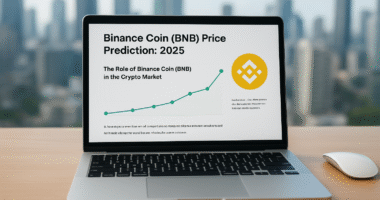From Binance to Coinbase: How Institutions Are Moving in Crypto This Week
Introduction
The global crypto market continues to evolve at high speed, and this week has been especially significant for institutional involvement. From major movements on Binance to strategic positioning on Coinbase, large financial players—including hedge funds, asset managers, and corporate treasuries—are signaling a shift in confidence. As regulatory clarity improves and market volatility stabilizes, institutions are once again reshaping liquidity, trading volume, and investor sentiment across the crypto ecosystem.
In this report, we examine how institutional inflows, exchange activity, and new compliance strategies are influencing the markets this week—and what it means for the future of digital assets.
Institutional Flows Surge Across Major Exchanges
A Rise in Trading Volume on Binance
This week, Binance recorded a noticeable increase in institutional trading volume, particularly in BTC and ETH pairs. While retail activity remains relatively steady, several large buy clusters were reported during mid-week sessions. Analysts believe these movements came from U.S. and Asian trading desks positioning themselves ahead of upcoming macroeconomic events such as U.S. inflation data and the Federal Reserve’s policy signals.
In addition, Binance’s liquidity depth has improved after months of restructuring its operations in Europe and the U.S. The exchange’s enhanced compliance measures appear to be restoring confidence among professional traders.
Coinbase Sees Strong Inflows From U.S. Institutions
Coinbase also observed a strong weekly influx into institutional accounts, with Coinbase Prime reporting elevated activity from asset managers and hedge funds. Much of this activity centered on:
- Bitcoin accumulation
- Ethereum staking-related purchases
- Stablecoin movements into USDC
- Allocations into top-tier altcoins such as SOL and AVAX
Given that Coinbase is the primary exchange used by regulated U.S. institutions, this surge is seen as a strong indicator of renewed confidence from corporate treasuries preparing for Q1 2026 positioning.
https://goldenraysnews.com/deutsche-boerse-offers-bitcoin-and-ether-custody/
Bitcoin and Ethereum Remain Institutional Favorites
Why Bitcoin Is Still the Preferred Hedge
Despite multiple new assets entering institutional portfolios, Bitcoin continues to dominate large-scale purchases. This week’s data suggests:
- Increased long-term holding from major funds
- Reduced sell pressure on BTC across centralized exchanges
- Strong options positioning in favor of continued upside
Institutions continue to treat Bitcoin as a digital macro hedge—particularly at a time when global inflation and interest rate uncertainty are influencing broader financial markets.
Ethereum Activity Boosted By Lower Fees
Ethereum is gaining renewed attention after its network upgrade recently reduced transaction costs. Lower fees have increased institutional interest in:
- DeFi liquidity pools
- Tokenization projects
- On-chain settlement systems
- ETH staking derivatives
Funds are increasingly viewing ETH as a technology investment rather than a speculative asset, especially as enterprises accelerate their adoption of blockchain for settlements.
Altcoins Stand Out as Institutions Diversify
Solana Gains Momentum
Solana remains one of the strongest institutional contenders outside BTC and ETH. This week:
- Trading volume increased sharply
- New institutional wallets accumulated SOL
- Solana ecosystem metrics showed strong daily active usage
Funds are attracted to the chain’s speed, cost efficiency, and growing developer ecosystem—especially for DeFi and gaming.
Layer-2 Tokens Draw Strategic Interest
Layer-2 ecosystems such as Arbitrum, Optimism, and Base also received increased attention from institutional desks. Their focus is driven by:
- High throughput
- Lower cost transactions
- Strong user onboarding metrics
- Expanding enterprise use cases
As Ethereum scales, institutions want early exposure to the infrastructure that supports future blockchain adoption.
Regulatory Clarity Encourages More Institutional Participation
U.S. Regulatory Environment Improves
For the first time in years, the U.S. regulatory landscape is less chaotic. With clearer frameworks emerging around stablecoins, exchange licensing, and digital asset custody, institutions are feeling more confident entering the space.
Coinbase and Kraken have continued to expand institutional custody products, while Binance has increased compliance staffing and reporting transparency across multiple jurisdictions.
Europe and Asia Accelerate Adoption
Europe’s MiCA regulation, which is entering full implementation, has boosted institutional comfort and provided standardized compliance rules. Meanwhile, Asia—particularly Singapore and Hong Kong—is aggressively attracting asset managers looking to enter regulated crypto markets.
https://goldenraysnews.com/bitcoin-etfs-see-heavy-outflows-as-solana-shines/
What This Means for the Market Going Forward
Institutional Demand Could Set the Tone for 2025–2026
The ongoing accumulation on both Binance and Coinbase is likely to influence market direction in the coming months. If macroeconomic conditions stabilize, institutional capital may push Bitcoin and major altcoins into a stronger long-term uptrend.
Long-Term Holders Are Increasing
Across blockchain analytics platforms, long-term institutional holding metrics have risen. This suggests professional investors see digital assets as a multi-year investment rather than short-term speculation.
On-Chain Activity Will Keep Growing
As more institutions adopt tokenization, staking, and blockchain settlement tools, on-chain volume is expected to rise. This will contribute to a healthier, more robust crypto environment.
Conclusion
This week’s activity from Binance to Coinbase shows a clear trend: institutions are re-entering the crypto market with strategic, long-term intentions. Their movement signals growing confidence in digital assets, improved global regulation, and an increasing recognition of blockchain’s role in the financial system.
As institutional flows continue to build, the crypto landscape is likely entering a new phase—one defined by stability, maturity, and sustained growth.








